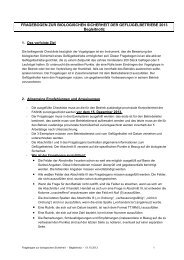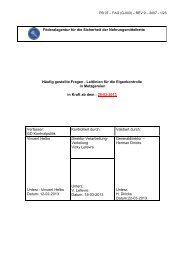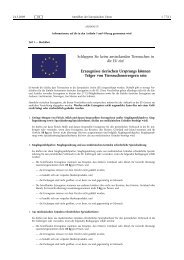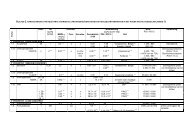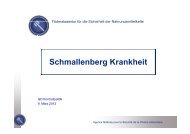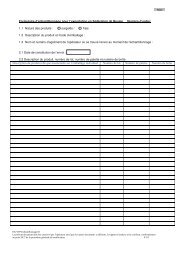Direct marketing from producers to consumers: Economic ... - Favv
Direct marketing from producers to consumers: Economic ... - Favv
Direct marketing from producers to consumers: Economic ... - Favv
Create successful ePaper yourself
Turn your PDF publications into a flip-book with our unique Google optimized e-Paper software.
<strong>Direct</strong> <strong>marketing</strong> <strong>from</strong> <strong>producers</strong> <strong>to</strong><br />
<strong>consumers</strong>:<br />
<strong>Economic</strong> aspects and key success<br />
fac<strong>to</strong>rs<br />
Erwin Wauters, Koen Mondelaers, Maarten Crivits<br />
Symposium Food Safety of the Short Supply Chain<br />
9 th November, 2012<br />
Institute for Agricultural and Fisheries Research<br />
Social Sciences Unit<br />
www.ilvo.vlaanderen.be<br />
Agriculture and Fisheries Policy Area
Background<br />
2
Background<br />
ILVO<br />
� ILVO conducts multi-disciplinary, innovative and<br />
independent research with a view <strong>to</strong> enhance the<br />
sustainability and competitiveness of agriculture and rural<br />
areas<br />
� Based on research, ILVO develops knowledge and <strong>to</strong>ols,<br />
for improving products and production technologies, for<br />
safeguarding quality and safety of food products, for<br />
informing policy and sec<strong>to</strong>r and for enhancing rural<br />
development processes<br />
3
Background<br />
Social Sciences Unit<br />
� Mission: To present and clarify, on a scientific basis, the<br />
social choices concerning a sustainable and competitive<br />
Flemish agriculture, fisheries and countryside<br />
� Agricultural and farm development group: socio-economic<br />
research on the sustainability, profitability, effectiveness,<br />
productivity and resilience of farming systems<br />
� Rural development group: socio-economic research on<br />
spatial transformations, multifunctionality, regional<br />
development, governance processes and multistakeholders<br />
processes<br />
4
Background<br />
5
Introduction<br />
6
Introduction<br />
<strong>Direct</strong> <strong>marketing</strong> <strong>from</strong> economic, social and ecological point of view<br />
• When direct <strong>marketing</strong> started <strong>to</strong> become a <strong>to</strong>pic<br />
among people concerned with all things agricultural<br />
and rural, the focus was on its potential <strong>to</strong> provide<br />
income <strong>to</strong> – mostly – small-scale farmers<br />
– Alternative <strong>to</strong> conventional market<br />
– Increase margin over costs<br />
– Circumvent market power of retailers and traders<br />
• Since late 90s, attention shifted on what direct<br />
<strong>marketing</strong> could accomplish in terms of socioecological<br />
sustainability<br />
7
Introduction<br />
<strong>Direct</strong> <strong>marketing</strong> <strong>from</strong> economic, social and ecological point of view<br />
• Since crisis of 2008-2009 direct <strong>marketing</strong> is, again,<br />
proposed as one of the answers <strong>to</strong> decreasing<br />
margins, market power of big traders and retailers<br />
8
Introduction<br />
Observations<br />
� A lot of statements are made about short supply chains:<br />
� “Less food miles so environmentally more sustainable”<br />
� “Short supply chains increase farmrs’ income because of the<br />
higher price”<br />
� “Short supply chains are the solution for low incomes in<br />
agriculture”<br />
� “Food bought in short supply chain is healthier”<br />
� These are treated as axioms (things that don’t need<br />
proof)<br />
� While in fact they are statements (things that can be<br />
proven true or untrue – or rather (un)true in certain<br />
circumstances)<br />
9
Introduction<br />
Content of contributions<br />
� Insights in<strong>to</strong> the economics of direct <strong>marketing</strong><br />
� Based on theoretical considerations<br />
� Based on general farm economics<br />
� Based on the limited empirical evidence<br />
� Some key success fac<strong>to</strong>rs for economically successful<br />
direct <strong>marketing</strong> strategies<br />
10
The basic model : theory<br />
11
The basic model : theory<br />
� Every business analysis should be based on<br />
� <strong>Economic</strong> analysis: tells you whether something is worth doing or<br />
which alternative is most worth doing<br />
� Cash-flow analysis: tells you how much cash is involved, when and<br />
whether cash obligations are likely <strong>to</strong> be met<br />
� Risk analysis: tells you how vulnerable the business becomes (after<br />
the decision) <strong>to</strong> unexpected values for key parameters such as<br />
prices and production<br />
� The empirical comparison of income on farms with and<br />
without direct <strong>marketing</strong> might not tell you a lot<br />
� Attribution problem<br />
<strong>Economic</strong> analysis<br />
� Farms in your sample with direct <strong>marketing</strong> are success s<strong>to</strong>ries,<br />
failures exist as well<br />
12
The basic model : theory<br />
Income: The choice between <strong>marketing</strong> channels<br />
13
The basic model : theory<br />
Income: The choice between <strong>marketing</strong> channels<br />
14
The basic model: theory<br />
Income: The choice between <strong>marketing</strong> channels<br />
� This is just basic economics: your decisions are based<br />
on what you gain and what you must give up<br />
� You compare benefits and costs<br />
� Yet, most sources (internet, leaflets, etc.) talk about<br />
higher prices, but do not talk about costs<br />
� Income does NOT solely depend on prices<br />
� Strategies resulting in higher prices only lead <strong>to</strong> higher income<br />
if the associated costs do not increase as much as the price<br />
15
Prices and costs in direct <strong>marketing</strong><br />
16
Benefits and costs in direct <strong>marketing</strong><br />
Specific <strong>marketing</strong> costs<br />
� Costs associated with a particular <strong>marketing</strong> channel<br />
� Think not only of pure <strong>marketing</strong> costs<br />
� Rather, think of all costs that you would not have hadn’t you<br />
chosen that particular <strong>marketing</strong> channel<br />
� Costs differ across direct <strong>marketing</strong> channels<br />
17
Benefits and costs in direct <strong>marketing</strong><br />
� Labour requirements associated with certain types of direct<br />
<strong>marketing</strong> might be very substantial, e.g., farm shop, farmers’<br />
market, roadside stand require significant amounts of labour<br />
� Whereas labour costs do not appear in a cash flow analysis, it<br />
is an economic cost<br />
� Differs across channels<br />
� Moreover, even when not a cash cost, labour requirements<br />
might have indirect effects on cach income<br />
� Time spent in the farm shop cannot be spent on the field<br />
� Labour flexibility is reduced<br />
Labour<br />
18
Benefits and costs in direct <strong>marketing</strong><br />
� Labour requirements associated with certain types of direct<br />
<strong>marketing</strong> might be very substantial, e.g., farm shop, farmers’<br />
market, roadside stand require significant amounts of labour<br />
� Whereas labour costs do not appear in a cash flow analysis, it<br />
is an economic cost<br />
� Differs across channels<br />
� Moreover, even when not a cash cost, labour requirements<br />
might have indirect effects on cach income<br />
� Time spent in the farm shop cannot be spent on the field<br />
� Labour flexibility is reduced<br />
Labour<br />
19
Benefits and costs in direct <strong>marketing</strong><br />
� Labour requirements associated with certain types of direct<br />
<strong>marketing</strong> might be very substantial, e.g., farm shop, farmers’<br />
market, roadside stand require significant amounts of labour<br />
� Whereas labour costs do not appear in a cash flow analysis, it<br />
is an economic cost<br />
� Differs across channels<br />
� Moreover, even when not a cash cost, labour requirements<br />
might have indirect effects on cach income<br />
� Time spent in the farm shop cannot be spent on the field<br />
� Labour flexibility is reduced<br />
Labour<br />
20
Benefits and costs in direct <strong>marketing</strong><br />
Fixed nature of many specific <strong>marketing</strong> costs<br />
� Price should be compared with specific <strong>marketing</strong> costs per<br />
additional unit of output sold on that <strong>marketing</strong> channel<br />
� However, quite a lot of specific <strong>marketing</strong> costs related <strong>to</strong><br />
direct <strong>marketing</strong> have a fixed nature, which means they<br />
don’t get smaller as sales decrease<br />
� These costs are incurred, whether you sell a lot or little,<br />
hence, when sales are low, specific <strong>marketing</strong> costs per unit<br />
sold might be that high that they offset the higher price<br />
received<br />
21
Benefits and costs in direct <strong>marketing</strong><br />
� Examples<br />
� Promotion<br />
� Market entry fees<br />
� Farm shop<br />
� Market stand<br />
� Transport<br />
� Sanitary requirements<br />
� Packaging equipment<br />
� Farm shop personnel<br />
� S<strong>to</strong>rage<br />
Fixed nature of many specific <strong>marketing</strong> costs<br />
� Processing equipment<br />
22
Benefits and costs in direct <strong>marketing</strong><br />
Fixed nature of many specific <strong>marketing</strong> costs<br />
� Fixed nature counters one of the advantages of direct<br />
<strong>marketing</strong>, the ability <strong>to</strong> enter the market at a small scale<br />
� A certain minimum scale is still needed in order for certain direct<br />
<strong>marketing</strong> channels <strong>to</strong> be profitable<br />
� Certain direct <strong>marketing</strong> channels require significant investments,<br />
such that certain volumes might just be <strong>to</strong>o small<br />
“With all these regulations and things you must install before you are<br />
even allowed (and then I’m not talking yet about the equipment itself) <strong>to</strong><br />
sell your own dairy products, you cannot start small” (Farmer x <strong>from</strong> Y)<br />
23
Benefits and costs in direct <strong>marketing</strong><br />
� In direct <strong>marketing</strong> channels<br />
� Higher prices are received for sold products only<br />
� While specific <strong>marketing</strong> costs are incurred for all products supplied<br />
<strong>to</strong> the market<br />
� Implies a cost <strong>to</strong> the farmer<br />
Unsold product<br />
� Consequence of the perishable nature of most products<br />
supplied <strong>to</strong> short supply chains (vegetables, fresh fruit, dairy<br />
products, meat products)<br />
24
Benefits and costs in direct <strong>marketing</strong><br />
� Are costs incurred when changing <strong>from</strong> one channel <strong>to</strong><br />
another (Verhaegen and Van Huylenbroeck)<br />
� Distinguish between<br />
Transaction costs<br />
� TC related <strong>to</strong> the selling activity<br />
� TC related <strong>to</strong> the acquisition of the necessary skills<br />
25
Benefits and costs in direct <strong>marketing</strong><br />
Transaction costs<br />
� TC related <strong>to</strong> the selling activity<br />
� Number of transactions in direct <strong>marketing</strong> typically increases a lot,<br />
with respect <strong>to</strong> conventional markets<br />
� Farmers that do not use the conventional market for a while, may<br />
incur additional transaction costs related <strong>to</strong> being well informed<br />
about market conditions and prices<br />
� TC related <strong>to</strong> the acquisition of the necessary skills<br />
� Farmers in the direct market may be less infomed about new<br />
production methods<br />
� Farmers have <strong>to</strong> acquire <strong>marketing</strong> skills<br />
26
Benefits and costs in direct <strong>marketing</strong><br />
Transaction costs<br />
� TC related <strong>to</strong> the selling activity<br />
� Number of transactions in direct <strong>marketing</strong> typically increases a lot,<br />
with respect <strong>to</strong> conventional markets<br />
� Farmers that do not use the conventional market for a while, may<br />
incurr additional transaction costs related <strong>to</strong> being well informed<br />
about market conditions and prices<br />
� TC related <strong>to</strong> the acquisition of the necessary skills<br />
� Farmers in the direct market may be less infomed about new<br />
production methods<br />
� Farmers have <strong>to</strong> acquire <strong>marketing</strong> skills<br />
27
Benefits and costs in direct <strong>marketing</strong><br />
� General idea is that direct <strong>marketing</strong> implies a less risky farm<br />
business<br />
� Prices are more certain<br />
Risk<br />
� However, market risk (the risk of selling less than expected)<br />
may be higher<br />
� Conventional markets generally buy all produce that is supplied<br />
� In direct markets, this is less certain<br />
� Success of farmers’ markets, farm shops, roadside stands depends on number of<br />
cus<strong>to</strong>mers, which is highly uncertain<br />
� CSA and similar forms of direct <strong>marketing</strong> spread the risk more equally between<br />
producer and consumer<br />
� Lower price risk, but more market risk can have equal impact on<br />
income (higher prices are only received for produce that is sold,<br />
<strong>marketing</strong> costs are incurred for everything that is supplied)<br />
28
Benefits and costs in direct <strong>marketing</strong><br />
Risk and trust<br />
� The nature of risk is changed through the mechanism of<br />
trust<br />
� In conventional markets, due <strong>to</strong> increased distance between<br />
producer and consumer<br />
� Alternative mechanisms such as labels, brands, certification need <strong>to</strong><br />
be devised <strong>to</strong> create trust<br />
� In direct markets, the farmer materializes trust ‘in persona’<br />
� The short distance is seen as the corners<strong>to</strong>ne of direct selling<br />
� However, the absence of any “objective” measure of trust<br />
makes the performance of direct <strong>marketing</strong> channels (the<br />
sales) susceptible <strong>to</strong> changes in the level of trust<br />
� Importance of direct <strong>marketing</strong> certification schemes etc.<br />
29
Benefits and costs in direct <strong>marketing</strong><br />
Risk and trust<br />
� The nature of risk is changed through the mechanism of<br />
trust<br />
� In conventional markets, due <strong>to</strong> increased distance between<br />
producer and consumer<br />
� Alternative mechanisms such as labels, brands, certification need <strong>to</strong><br />
be devised <strong>to</strong> create trust<br />
� In direct markets, the farmer materializes trust ‘in persona’<br />
� The short distance is seen as the corners<strong>to</strong>ne of direct selling<br />
� However, the absence of any “objective” measure of trust<br />
makes the performance of direct <strong>marketing</strong> channels (the<br />
sales) susceptible <strong>to</strong> changes in the level of trust<br />
� Importance of direct <strong>marketing</strong> certification schemes etc.<br />
30
Benefits and costs in direct <strong>marketing</strong><br />
In sum<br />
� Theoretical impact of direct <strong>marketing</strong> is unclear<br />
� Higher prices AND changes in <strong>marketing</strong> costs must be taken in<strong>to</strong><br />
account<br />
� The nature of the risk involved changes as well<br />
� Hence, economic impact is an empirical issue<br />
� It is thus surprising that little empirical research has been conducted<br />
� Large amount of statements bears no relationship with small amount<br />
of empirical work<br />
31
Benefits and costs in direct <strong>marketing</strong><br />
� Labour<br />
Some facts<br />
� De Regt et al. (2010): when a value on own unpaid labour was set,<br />
net profit of direct <strong>marketing</strong> in dairy farms was negative<br />
� Several authors <strong>from</strong> the US found that costs related <strong>to</strong> time and<br />
labour were the most significant obstacles <strong>to</strong> expansion of local food<br />
sales<br />
� Some work on comparison of specific costs across different<br />
forms of direct <strong>marketing</strong>.<br />
� Verhaegen and Van Huylenbroeck: all specific <strong>marketing</strong><br />
costs are compensated for by a higher price<br />
� Duffy: net returns <strong>to</strong> land on CSA farm is much higher than<br />
on conventional farms BUT more than 50% of the farmers<br />
found net return <strong>to</strong> labour insufficient<br />
32
Benefits and costs in direct <strong>marketing</strong><br />
� Diversification of <strong>marketing</strong> channels<br />
� Scale of sales<br />
� Managerial ability<br />
� Farm characteristics<br />
� Passion, attitude and effort<br />
Conclusion: success fac<strong>to</strong>rs<br />
33
Thank you!<br />
Erwin.Wauters@ilvo.vlaanderen.be<br />
Institute for Agricultural and Fisheries Research<br />
Social SciencesUnit<br />
www.ilvo.vlaanderen.be<br />
Agriculture and Fisheries Policy Area


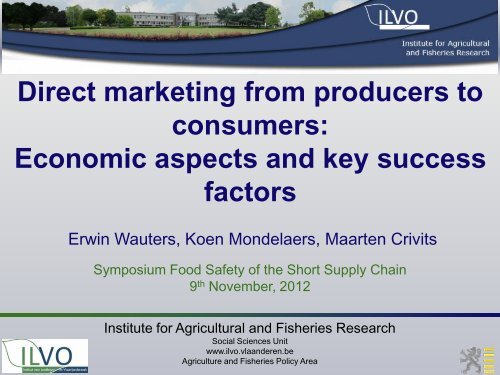
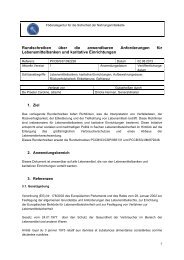
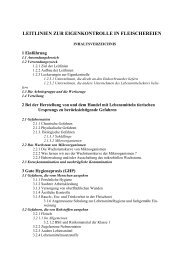

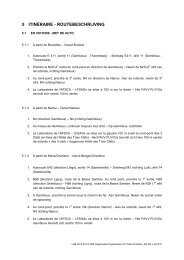
![DPA 2298 Schweine: Aujeszky-Impfung [2298] v2 - FAVV](https://img.yumpu.com/22032815/1/184x260/dpa-2298-schweine-aujeszky-impfung-2298-v2-favv.jpg?quality=85)
